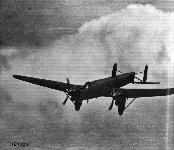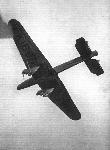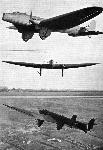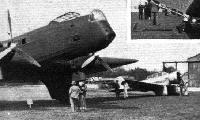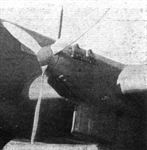
Описание
Страна : Великобритания
Год : 1930
Тяжелый бомбардировщик с экипажем из пяти человек
Fairey Hendon
Спецификация Министерства авиации B.19/27 к тяжелому ночному бомбардировщику привела к заключению контрактов на постройку двух совершенно разных машин: биплана Handley Page Heyford и моноплана Hendon, имевшего металлическую конструкцию с полотняной обшивкой. Hendon представлял собой более перспективный самолет, но ряд выявленных на испытаниях дефектов заставил основательно пересмотреть его конструкцию. В результате в серию пошел Heyford, размноженный в количестве 121 единицы, а производство Hendon ограничилось 14 самолетами.
Первый полет прототип Hendon Mk I выполнил 17 ноября 1931 года с двумя звездообразными моторами Bristol Jupiter, хотя точно марка мотора не установлена - или 460-сильный Jupiter VIII, или Jupiter XF мощностью 525 л.с. В 1932 году моторы Jupiter заменили двигателями жидкостного охлаждения Rolls-Royce Kestrel IIIS мощностью 480 л.с.; на серийных Hendon Mk II ставились Kestrel VI. Серийное производство продолжалось с сентября 1936 года по март 1937 года, в строевые части самолеты начали поступать в ноябре 1936 года. Hendon укомплектовали единственную эскадрилью - 38-ю в Хэндоне, а также одно звено 115-й эскадрильи.
Hendon стал первым монопланом, поступившим на вооружение строевых частей британских ВВС и первым двухмоторным самолетом "Fairey", если не считать F.2 образца 1917 года. Самолет обладал рядом интересных особенностей: бомбы и топливо размещены внутри; хвостовая и носовая стрелковые точки соединены лазом, проходящим через весь фюзеляж; кабина летчиков закрытая. Был заключен, но потом аннулирован, контракт на постройку дополнительных 62 самолетов с моторами Kestrel VI мощностью 695 км/ч, вращающейся носовой турелью и рядом иных улучшений.
Только два Hendon разбилось за время эксплуатации, прежде чем им на смену в ноябре 1938 года пришел Vickers Wellington.
ТАКТИКО-ТЕХНИЧЕСКИЕ ХАРАКТЕРИСТИКИ
Fairey Hendon Mk II
Тип: тяжелый бомбардировщик с экипажем из пяти человек
Силовая установка: два V-образных ПД Rolls-Royce Kestrel VI мощностью по 600 л. с. (448 кВт)
Летные характеристики: максимальная скорость на высоте 4570 м - 249 км/ч; крейсерская скорость на высоте 4570 м - 214 км/ч; начальная скороподъемность 287 м/мин; практический потолок 6525 м; дальность 2189 км
Масса: пустого 5794 кг; максимальная взлетная 9072 кг
Размеры: размах крыла 31,01 м; длина 18,52 м; высота 5,72 м; площадь крыла 134,43 м'
Вооружение: по одному турельному 7,7-мм пулемету Lewis в носовой, средней и хвостовой частях фюзеляжа; до 753 кг бомб в фюзеляжном бомбоотсеке и на внешней подвеске под фюзеляжем - обычно одна 454-кг бомба или шесть 113-кг, или 12 51-кг бомб на внутренней подвеске и восемь 9,1-кг бомб на внешней подвеске
- Описание
Фотографии
-
Air Enthusiast 2003-03 / B.Dunn - Half-way house
Регистрационный номер: K1695 [8] The Fairey B19/27 K1695 which was followed by a small production run, as the Hendon.
-
Flight 1932-06 / Flight
ANOTHER NEW AIRCRAFT TYPE WHICH WILL BE SEEN AT THE DISPLAY AT HENDON ON JUNE 25: The Fairey Night Bomber (two Rolls-Royce "Kestrel" engines) is the only monoplane among the new machines of this class. It has a wing span of more than 100 ft., and the gross weight is 19,050 lb.
Другие самолёты на фотографии: Fairey Gordon / Seal - Великобритания - 1931
-
Flight 1932-07 / Flight
"NEW AND EXPERIMENTAL": In front the Fairey Night Bomber (two "Kestrel"), and behind it the new Blackburn ten-passenger machine (two "Jaguar").
Другие самолёты на фотографии: Blackburn CA.15 Monoplane/Biplane - Великобритания - 1932
-
Aeroplane Monthly 1984-06 / A.Lumsden, T.Heffernan - Probe Probare (4)
Further view of the prototype Hendon.
-
Flight 1934-08 / Flight
FOR THE ROYAL AIR FORCE: The Fairey night bomber (2 Rolls-Royce "Kestrels") is now in production and will be the first monoplane, apart from amphibian flying boats, to be issued to the R.A.F. The machine as here seen was being piloted by Flt. Lt. C. Staniland, Fairey's chief test pilot.
-
Aeroplane Monthly 1988-02 / K.Desmond - Richard Fairey 1887-1956 (2)
The Hendon, Fairey’s only heavy bomber.
-
Aeroplane Monthly 1984-06 / A.Lumsden, T.Heffernan - Probe Probare (4)
Регистрационный номер: K1695 [8] -
Aviation Historian 12 / M.Willis - From Swordfish to Firefly /Duncan Menzies/ (2)
Регистрационный номер: K1695 [8] На фотографии прототип самолета Hendon. В крейсерском полете машина выглядела необычно - хвостовая часть находилась выше носовой.
The Hendon prototype, K1695, in its usual nose-down attitude during a photographic sortie with Fairey’s chief test pilot Chris Staniland at the controls. The type entered RAF service with No 38 Sqn at Mildenhall in November 1936, the Service’s 14 Hendons operating until late 1938, when they were replaced by Wellingtons. -
Flight 1935-01 / Flight Advertisements
Регистрационный номер: K1695 [8] THE FAIREY LONG-RANGE NIGHT BOMBER. The Air Ministry have placed an order to equip one squadron with this type. Flt, Lt. C. Staniland on a test flight
-
Flight 1934-11 / Flight
The "Hendon" Night Bomber (two Rolls-Royce "Kestrels");
-
Flight 1934-05 / Flight
Регистрационный номер: K1695 [8] THE FAIREY NIGHT BOMBER: In spite of its 8 1/2 - 9 tons, Mr. C. Staniland, Fairey's Chief Test Pilot, "throws it about" in an amazing fashion. The engines are Rolls-Royce "Kestrel" III.S, which develop 480 b.h.p. at 11 000 ft. Note the rounded triangle section of the fuselage, which enables the gunner to fire downwards.
Further view of the prototype Hendon. The triangular fuselage section aft of the wings is seen to good effect in the photograph. -
Aeroplane Monthly 1984-06 / A.Lumsden, T.Heffernan - Probe Probare (4)
Регистрационный номер: K1695 [8] -
Flight 1932-12 / Flight
Регистрационный номер: K1695 [8] BREAKING NEW GROUND: In the design of the new Fairey night bomber (two Rolls-Royce "Kestrel") every effort has been made to achieve aerodynamic efficiency, and for the first time in the history of British aviation a night bomber has been produced as a cantilever monoplane. The size of the machine may be gauged from that of the visible crew. When these photographs were taken the machine was piloted by Flt. Lt. Staniland, Fairey's Chief Test Pilot.
-
Aeroplane Monthly 1984-06 / A.Lumsden, T.Heffernan - Probe Probare (4)
Регистрационный номер: K1695 [8] -
Aeroplane Monthly 1984-06 / A.Lumsden, T.Heffernan - Probe Probare (4)
A DISTANT RELATION: Flt. Lt. Staniland piloting a Fairey Hendon heavy bomber over the maker's aerodrome, as seen from the tail cockpit. The first production machines, now coming along from the Stockport works, have a nose turret and enclosed cockpit
View forward from the Fairey Hendon's dorsal gun position during a dive on Fairey's new aerodrome at Harmondsworth in May 1934. -
Aeroplane Monthly 1984-06 / A.Lumsden, T.Heffernan - Probe Probare (4)
Fairey's chief test pilot, Chris Staniland, sitting in the open cockpit of the Hendon prototype in May 1934. All subsequent Hendons had enclosed cockpits.
-
Jane's All the World Aircraft 1938 / 03 - All the world's aeroplanes
The Fairey "Hendon" Night Bomber (two Rolls-Royce "Kestrel VI" engines).
-
Flight 1936-01 / Flight
This British machine is the subject of large Air Ministry contract: the Fairey Hendon. This type, as at present being built, mount the 600-h.p. Rolls-Royce Kestrel VI, which is supercharged to give that power at 11,000 ft.
-
Aviation Historian 25 / G.Baughen - The case for appeasement?
In common with the Armee de I’Air’s Amiot 143, the Fairey Hendon was largely designed to a late-1920s specification, in the latter’s case B.19/27 for a “Night Bombing Landplane”. The Hendon became the first all-metal low-wing cantilever monoplane to join the RAF when it entered service with No 38 Sqn at Mildenhall in late 1936.
-
Flight 1935-12 / Flight
The Fairey Hendon fitted with 600 h.p. Kestrel VI's.
-
Flight 1935-05 / Flight
The Fairey "Hendon" night bomber in its new guise - with a nose "conservatory" and three-bladed airscrews. In the background is the Northrop bomber from Farnborough.
Другие самолёты на фотографии: Northrop Gamma / A-13 / A-16 - США - 1932
-
Flight 1935-07 / Flight
Water-cooled representatives: The Fairey "Hendon" heavy bomber on the left has Rolls-Royce "Kestrel" engines, while the "Fantome" on the right has the Hispano-Suiza moteur canon.
Другие самолёты на фотографии: Fairey Fantome / Feroce - Бельгия - 1935
-
Flight 1935-08 / Flight
In its production form the Fairey "Hendon" will have 600 h.p. "Kestrels," a cupola for the front gunner, and an enclosed pilot's cockpit.
-
Flight 1938-12 / Flight
A fixed-pitch Fairey as used for the Kestrel engines of the Fairey Hendon.
-
Flight 1939-07 / Flight
At Hendon last Monday. A general view of some of the aeroplanes on view, with the nose of the Fairey "Hendon" in the foreground.
The unusual installation of the Kestrels in the Fairey Hendon bomber featured radiators in front of the “trousers” and a peculiar exhaust system, forerunner of the “ramshorn” type. -
Aviation Historian 12 / M.Willis - From Swordfish to Firefly /Duncan Menzies/ (2)
Регистрационный номер: K5085 Fairey’s only foray into heavy bomber design, the Rolls-Royce Kestrel-engined Hendon was the first such cantilever monoplane to be built in Britain. The first production Hendon, K5085, seen here, was test-flown by Menzies in September 1936.
-
Flight 1935-08 / Flight
The Fairey "Hendon" heavy bomber not only has one gun position in the nose and one behind the wings firing upwards, but also one behind the rudders which commands a complete hemisphere.
-
Мировая Авиация 98
25 ноября 1930г.: первый полет бомбардировщика-моноплана Fairey Hendon. Эти машины поступили на вооружение 38-й эскадрильи британских ВВС в 1936 году.
-
Flight 1935-02 / Flight Advertisements
FAIREY 'HENDON' WITH TWO ROLLS-ROYCE 'KESTREL' ENGINES
-
Flight 1938-05 / Flight
Hendons oi No. 38 Squadron. The depth of the wing and the unusual cockpit arrangements are worth noting.
-
Flight 1938-05 / Flight
A Fairey Hendon bomber belonging to No. 38 (B.) Squadron takes off from Marham for an Empire Air Day rehearsal
-
Aeroplane Monthly 1988-12
First flight of Fairey Night Bomber (Hendon), November 25, 1930
-
Мировая Авиация 125
Fairey Hendon
- Фотографии




